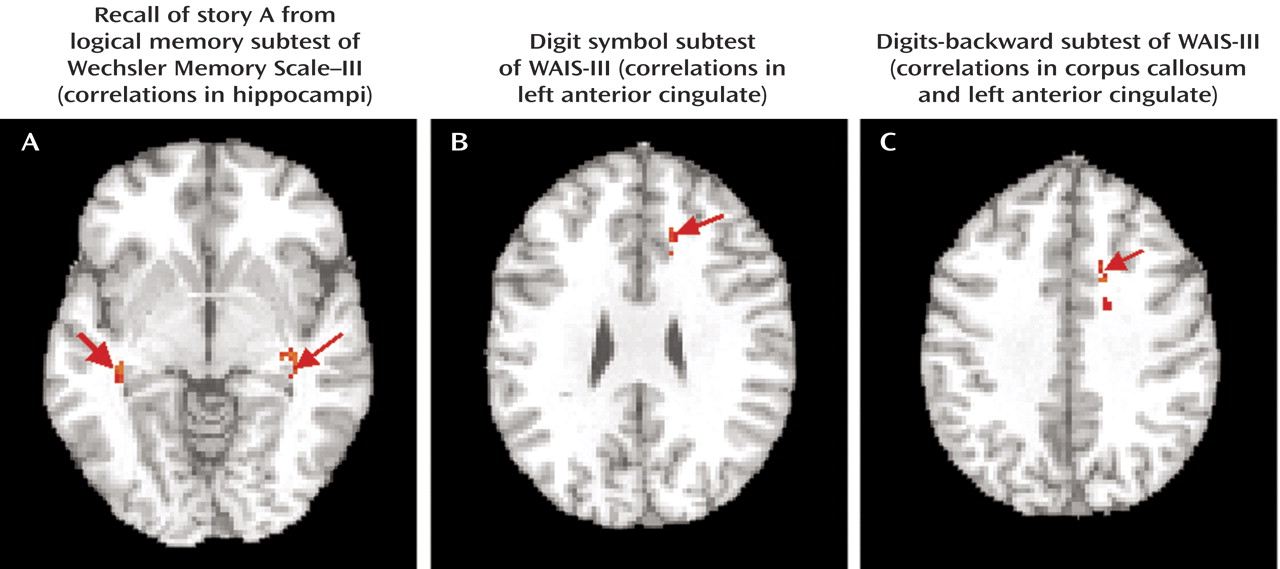Patients with schizophrenia have impairments in cognitive functions that require operation of neural networks. However, we are aware of only one study that examined correlations between cognitive function and white matter integrity in schizophrenia
(1) . This study found positive correlations between verbal memory and white matter integrity in the left uncinate fasciculus and between executive function and the left cingulate bundle area. It is clear that the neural networks underlying performance in different cognitive domains are not fully understood.
Cortical anatomical connectivity has been examined in vivo using diffusion tensor imaging, which measures the directionality and magnitude of diffusion in tissues. With barriers to diffusion, including myelin, cell membranes, or organized white matter tracts, diffusion will be greater parallel than perpendicular to the long axis of fibers (anisotropic diffusion).
The degree of diffusion anisotropy can be measured with fractional anisotropy, which has been found to be reduced in white matter in most studies of schizophrenia. This reduction has been interpreted as evidence of impaired white matter integrity, which is consistent with findings of reduced expression of myelin-related genes
(2) and a reduced number of oligodendrocytes
(3) .
We previously used a voxelwise approach and found reduced fractional anisotropy in patients relative to comparison subjects in the corpus callosum, parahippocampal gyrus, temporal lobe regions, medial occipital lobe, and the deep frontal perigenual region
(4) . In the current study, we used a voxelwise correlational analysis to understand the neural circuitry that may underlie performance in different cognitive domains. We present data showing differential relationships between fractional anisotropy and tasks that evaluate domains of memory, attention, and executive function that are impaired in schizophrenia.
Method
The participants were 25 patients (three women) with a diagnosis confirmed with the Structured Clinical Interview for DSM-IV
(5) of schizophrenia or schizoaffective disorder. The patients had a mean age of 36.4 years (SD=10.0), an education of 11.7 years (SD=2.0), and an illness duration of 14.0 years (SD=9.5). The participants were inpatients and outpatients recruited from the Rockland Psychiatric Center and Rockland County Department of Mental Health. All of the participants gave written informed consent to participate, and all procedures were approved by local institutional review boards.
The patients completed a neuropsychological test battery from which the following tasks were selected to evaluate three domains derived from a factor analysis
(6) : verbal declarative memory (N=19) was assessed by using immediate recall for story A from the logical memory subtest of the Wechsler Memory Scale—III
(7), attention (N=25) was assessed by using the scaled score for the digit symbol subtest of the WAIS-III, and executive function (N=20)
(7) was assessed by using the scaled score from the digit span-backward subtest of the WAIS-III
(7) .
Scanning was performed on the Nathan Kline Institute’s 1.5-T Siemens Vision System (Erlangen, Germany). Three main sequences were used: magnetization prepared rapidly acquired gradient echo (TR/TE=11.4/4.9 msec, matrix=256×256, field of view=300 mm, number of excitations=1, 1.17-mm slice thickness, 172 slices, no gap), turbo spin echo (TR/TE=5000/22,90 msec, matrix=256×256, field of view=224 mm, number of excitations=1.5-mm slice thickness, 26 slices, no gap), and diffusion tensor imaging
(8) (TR/TE=6000/100 msec, matrix=128×128, field of view=240 mm, 5-mm slice thickness, 20 slices, no gap, b=0 s
2 /mm, number of excitations=2, b=1000 s
2 /mm, six directions, number of excitations=4).
Diffusion tensor image processing and voxelwise correlational analysis was performed using customized software. The b=0 images were corrected for susceptibility-induced distortion and transformed into Talairach space by using methods described elsewhere
(4,
9) . The interpolated voxel size was 2×2×2 mm
3 . A white matter mask was generated by using a nonparametric threshold
(10) from the averaged fractional anisotropy map and used to segment the individual images.
The multiple comparisons problem represents a challenge for voxelwise methods; this was reduced by analyzing only white matter. We also selected an approach based on Baudewig et al.
(11) . We found “seed” voxels using p<0.0005 and then included adjacent voxels with p<0.005, with a minimum cluster volume of 96 mm
3 . The correlation map was superimposed onto a magnetization prepared rapidly acquired gradient echo image in Talairach space using AFNI
(12) . Because only white matter was analyzed and, in the absence of a Talairach white matter atlas, some of the specified anatomical regions represent the white matter adjacent to the region named below. Fractional anisotropy was age-adjusted before computation of the correlations. The correlations reported are those for the seed voxel.
Results
The participants averaged a score of 8.3 (SD=4.4) on the logical memory story A immediate recall (
Figure 1 A). Significant positive correlations were found bilaterally in the hippocampus and the posterior cingulate. Unilateral positive correlations were observed in the left parahippocampal and fusiform gyri and Brodmann’s area 20, the cingulate gyrus, Brodmann’s area 31, the posterior cingulate, white matter adjacent to the caudate tail, the insula, and the claustrum, as well as the right middle frontal and middle occipital gyri (0.72<r<0.83). Negative correlations were found in the right inferior frontal gyrus and putamen (r=–0.72).
The participants averaged a scaled score of 5.4 (SD=2.5) on the digit symbol task (
Figure 1 B). Positive correlations were observed bilaterally in the anterior cingulate; the fimbria-fornix; the left cingulate gyrus; the medial frontal gyrus; Brodmann’s areas 32, 9, and 44; the right claustrum; and white matter adjacent to the caudate (0.65<r<0.68). Negative correlations were found in the right cuneus (r=–0.64).
The participants averaged a scaled score of 6.0 (SD=2.6) on the digit span backward test (
Figure 1 C). Positive correlations were observed bilaterally in the anterior cingulate, the insula, and the body of the corpus callosum. Unilateral positive correlations were observed in the left cingulate gyrus; Brodmann’s areas 24, 31, and 32; the thalamic white matter; the precentral and postcentral gyrus; and the white matter adjacent to the globus pallidus and caudate, as well as the right Brodmann’s area 13 and the parahippocampal, middle occipital, and posterior cingulate gyri (0.70<r<0.76). There were no significant negative correlations.
Discussion
We have shown significant correlations of neurocognitive tasks with white matter fractional anisotropy in three domains known to be impaired in schizophrenia. The correlations are consistent with neuroanatomical substrates thought to underlie performance in each domain. For the verbal declarative memory domain, fractional anisotropy was significantly correlated in the bilateral hippocampal white matter. These regions are known to be involved in memory function. The left-sided predominance of correlations is consistent with the verbal task demands. For the attention domain, the correlations, particularly those in the anterior cingulate, the medial frontal gyrus, and the basal ganglia, are consistent with regions involved in attention. Finally, for executive function, the distribution of correlations in the anterior cingulate, the corpus callosum, the basal ganglia, and the parahippocampal white matter is consistent with regions involved in that domain. Parahippocampal correlations might reflect the memory demands of the task.
In summary, our results suggest that diffusion tensor imaging may identify altered neural circuitry involved in cognitive domains known to be impaired in schizophrenia. These results provide a strong argument for multimodal imaging studies that provide information on anatomical connectivity and function.


